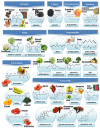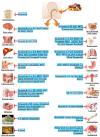Recent progress in natural dietary non-phenolic bioactives on cancers metastasis
- PMID: 29976413
- PMCID: PMC9303016
- DOI: 10.1016/j.jfda.2018.05.003
Recent progress in natural dietary non-phenolic bioactives on cancers metastasis
Abstract
From several decades ago to now, cancer continues to be the leading cause of death worldwide, and metastasis is the major cause of cancer-related deaths. For health benefits, there is a great desire to use non-chemical therapy such as nutraceutical supplementation to prevent pathology development. Over 10,000 different natural bioactives or phytochemicals have been known that possessing potential preventive or supplementary effects for various diseases including cancer. Previously, the in vitro and in vivo anti-invasive and anti-metastatic activities of phenolic acids, monophenol, polyphenol and their derivatives and flavonoids and their derivatives have been reviewed. However, a vast number of natural dietary compounds other than phenolics have been demonstrated to potentially possess the ability to inhibit the invasion and metastasis of various cancers. In this review, we summarize the studies in recent decade on in vitro and in vivo effects and molecular mechanisms of natural bioactives, excluding the phenolics in food, in cancer invasion and metastasis. By combining this review of non-phenolics with the previous phenolics reviews, the puzzle for the contribution of natural dietary bioactives on cancer invasive or/and metastatic progress will be almost complete and more clear.
Keywords: Angiogenesis; Invasion; Metastasis; Natural dietary bioactives.
Copyright © 2018. Published by Elsevier B.V.
Conflict of interest statement
None declared.
Figures



Similar articles
-
Chemopreventive effects of dietary phytochemicals against cancer invasion and metastasis: phenolic acids, monophenol, polyphenol, and their derivatives.Cancer Treat Rev. 2012 Feb;38(1):76-87. doi: 10.1016/j.ctrv.2011.03.001. Epub 2011 Apr 9. Cancer Treat Rev. 2012. PMID: 21481535 Review.
-
Flavonoids, a ubiquitous dietary phenolic subclass, exert extensive in vitro anti-invasive and in vivo anti-metastatic activities.Cancer Metastasis Rev. 2012 Jun;31(1-2):323-51. doi: 10.1007/s10555-012-9347-y. Cancer Metastasis Rev. 2012. PMID: 22314287 Review.
-
Therapeutic Potential of Plant Phenolic Acids in the Treatment of Cancer.Biomolecules. 2020 Feb 3;10(2):221. doi: 10.3390/biom10020221. Biomolecules. 2020. PMID: 32028623 Free PMC article. Review.
-
Phenolic Bioactives From Plant-Based Foods for Glycemic Control.Front Endocrinol (Lausanne). 2022 Jan 18;12:727503. doi: 10.3389/fendo.2021.727503. eCollection 2021. Front Endocrinol (Lausanne). 2022. PMID: 35116002 Free PMC article. Review.
-
An overview on the role of dietary phenolics for the treatment of cancers.Nutr J. 2016 Dec 1;15(1):99. doi: 10.1186/s12937-016-0217-2. Nutr J. 2016. PMID: 27903278 Free PMC article. Review.
Cited by
-
Dietary Flavonoids Luteolin and Quercetin Inhibit Migration and Invasion of Squamous Carcinoma through Reduction of Src/Stat3/S100A7 Signaling.Antioxidants (Basel). 2019 Nov 15;8(11):557. doi: 10.3390/antiox8110557. Antioxidants (Basel). 2019. PMID: 31731716 Free PMC article.
-
Use of Nutraceuticals in Angiogenesis-Dependent Disorders.Molecules. 2018 Oct 18;23(10):2676. doi: 10.3390/molecules23102676. Molecules. 2018. PMID: 30340320 Free PMC article. Review.
-
Chemopreventive Effect of β-Cryptoxanthin on Human Cervical Carcinoma (HeLa) Cells Is Modulated through Oxidative Stress-Induced Apoptosis.Antioxidants (Basel). 2019 Dec 27;9(1):28. doi: 10.3390/antiox9010028. Antioxidants (Basel). 2019. PMID: 31892217 Free PMC article.
-
Advances in Azorella glabra Wedd. Extract Research: In Vitro Antioxidant Activity, Antiproliferative Effects on Acute Myeloid Leukemia Cells and Bioactive Compound Characterization.Molecules. 2020 Oct 22;25(21):4890. doi: 10.3390/molecules25214890. Molecules. 2020. PMID: 33105817 Free PMC article.
References
-
- Stewart BW, Wild CP, editors. World cancer report 2014. Lyon: International Agency for Research on Cancer; 2014.
-
- Torre LA, Bray F, Siegel RL, Ferlay J, Lortet-Tieulent J, Jemal A. Global cancer statistics, 2012. CA Cancer J Clin. 2015;65:87–108. - PubMed
-
- Sliva D. Suppression of cancer invasiveness by dietary compounds. Mini Rev Med Chem. 2008;8:677–88. - PubMed
-
- Weng CJ, Yen GC. Chemopreventive effects of dietary phytochemicals against cancer invasion and metastasis: phenolic acids, monophenol, polyphenol, and their derivatives. Cancer Treat Rev. 2012a;38:76–87. - PubMed
-
- Weng CJ, Yen GC. Flavonoids, a ubiquitous dietary phenolic subclass, exert extensive in vitro anti-invasive and in vivo anti-metastatic activities (review) Cancer Metastasis Rev. 2012b;31:323–51. - PubMed
Publication types
MeSH terms
Substances
LinkOut - more resources
Full Text Sources
Other Literature Sources
Medical
